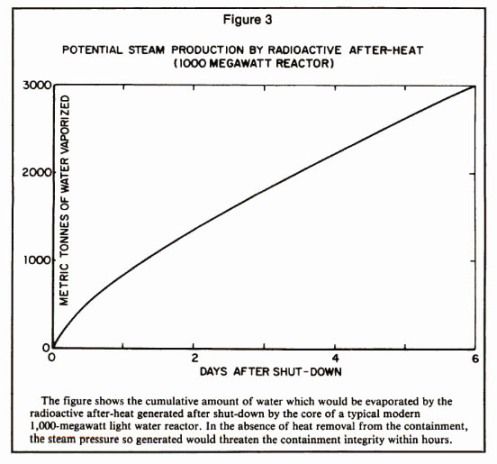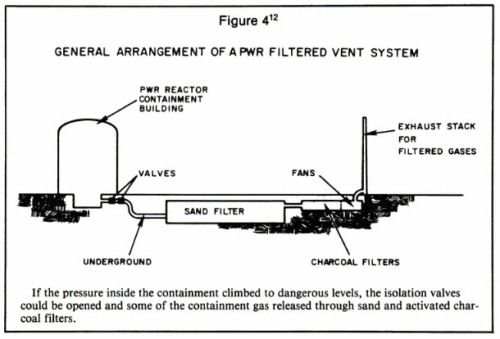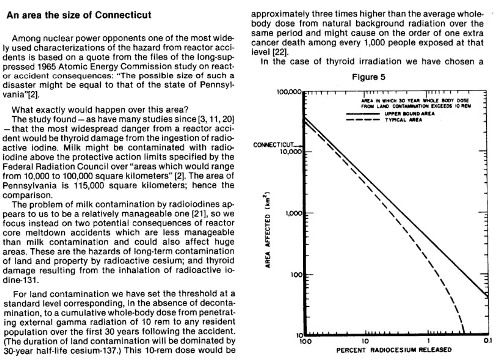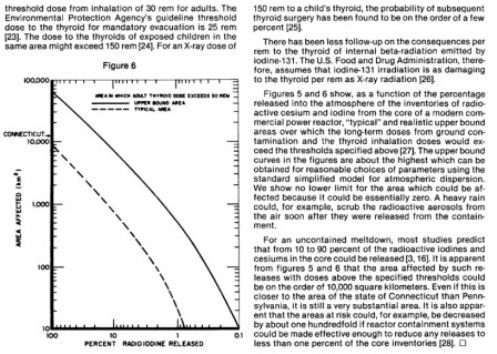From the Bulletin Archives: Containment of a reactor meltdown
By Frank von Hippel | March 16, 2011
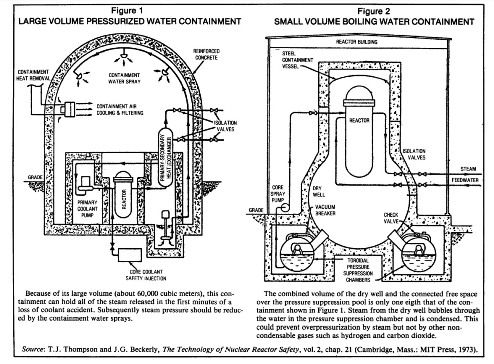
Editor’s Note: Authored by Jan Beyea and Frank von Hippel, this article originally appeared in the September 1982 issue of the Bulletin.
Any good scientist or engineer believes implicitly in Murphy’s law: “If something can go wrong, sooner or later it will go wrong.” The US Atomic Energy Commission, which until 1975 had the responsibility for ensuring the safety of US civilian power reactors, had many good scientists and engineers involved in its work. And during its history it repeatedly considered the consequences of all the safety systems in a nuclear reactor failing, the fuel melting and the volatile radioactive isotopes in the fuel being released to the atmosphere.
The answer which came back from major studies in 1957 [1], 1965 [2], and 1975 [3] was always that the consequences could be very serious indeed. This finding underlined the importance of preventing nuclear reactor meltdown accidents. As a result, the Atomic Energy Commission and the Nuclear Regulatory Commission (NRC), its successor in the area of nuclear safety regulation since 1975, required so many redundant safety systems on nuclear power plants that both nuclear regulators and the nuclear industry became convinced that the likelihood of a reactor meltdown accident had been reduced to a negligible level.
The massive failure of safety systems and the associated confusion which has occurred repeatedly at nuclear power plants since 1975 — with serious damage resulting at Brown’s Ferry in 1975 [4] and Three Mile Island in 1979 [5] — have, however, thrown this confidence into question. Our purpose here, therefore, is to draw wider attention to the possibilities for increased public protection offered by the last barrier between the radioactivity released from a molten core and the outside world: the reactor containment building.
The containment. Reactor containment buildings are both massive and well-equipped (Figures 1 and 2). Most are designed to withstand internal pressures of three to four atmospheres and may maintain their integrity at more than six atmospheres internal pressure. They also have water sprays, water pools or compartments full of ice-whose purpose is to reduce pressures by removing steam from the containment atmosphere.
Reactor containment buildings today are not designed to contain a reactor core meltdown accident, however. Their “design basis accident” is a loss-of-coolant accident in which large amounts of volatile radioisotopes are released from a temporarily over-heated core, but in which the uncontrolled release of energy from the core into the containment atmosphere is terminated by a flood of emergency core cooling water before an actual meltdown occurs. This is essentially what happened during the accident at Three Mile Island although, due to various errors, the core remained only partially cooled for a period of hours.
The threat of overpressurization. If for any reason the emergency core cooling system were not effective and a core meltdown occurred, the build-up of internal pressure in a sealed reactor containment building could rupture it within a matter of hours. The threat would come from steam, hydrogen and other gases.
For an extended period of time after a reactor shutdown, the radioactive fission products in a reactor core generate heat at a rate great enough to turn hundreds of metric tons of water into steam per day (Figure 3). It would take only about 300 metric tons of steam to increase the pressure inside even a large (60,000 cubic meter volume) Three Mile Island type of containment building by about ten atmospheres. It is apparent, therefore, that unless the containment cooling system operates reliably and effectively to keep this steam pressure from building up, the containment will quickly be overpressured by steam alone [6].
Hydrogen is another potential contributor to the pressurization of the containment. It is produced when water or steam comes into contact with a metal which binds oxygen so strongly that the metal can take oxygen away from water molecules. Because it absorbs relatively few neutrons, one such metal, zirconium, is the structural material of choice used in the cores of water cooled reactors. Zirconium starts reacting rapidly with steam at temperatures above 1,100 degrees C. About one half the zirconium in the core of Three Mile Island Unit No. 1 was oxidized during the accident there [7].
For a small volume (boiling water reactor type) containment, the mere pressure developed by the amount of hydrogen generated at Three Mile Island would have been enough to raise the containment pressure by one to three atmospheres.
For a large volume containment, the principal hazard associated with the hydrogen would be fire or explosion, and in fact the hydrogen did burn at Three Mile Island. Fortunately, however, the initial pressure in the containment building was such that the containment was able to withstand the resulting pressure increase of about two atmospheres. Some existing reactor containments would not have withstood the pressure rise associated with the burning of this much hydrogen – even given an initially low pressure.
In small boiling water reactor containments the probability of a hydrogen fire is eliminated by “inerting” the containment with an atmosphere of pure nitrogen. This is not done, however, in ice condenser containments, which are designed to withstand much lower internal pressures than most other containments. On September 8, 1980, during a final review of the design of Sequoyah Nuclear Power Plants, Units 1 and 2 (which are equipped with ice condenser containments) the NRC’S watchdog, the Advisory Committee on Reactor Safeguards, pointed out in a letter to the Commission that: “For events involving more than 30 percent oxidation of the zirconium, hydrogen control measures may be necessary to avoid containment failure.”
The remaining threat to containment integrity from overpressurization during a core meltdown accident would arise from the carbon dioxide and carbon monoxide liberated as the molten core melted its way down through the concrete basemat of the reactor building [8; 9].
This listing is sufficient to suggest why one of today’s small volume reactor containment buildings would probably rupture during a core meltdown accident and why there is a significant, although less certain, probability of failure for a large volume pressurized water reactor type containment [3].
The regulatory response. The situation we have just described was first explored by an Atomic Energy Commission advisory committee in 1966 when the AEC was just beginning to license the construction of today’s large commercial power reactors. The advisory committee recommended in its report, however, that the Commission should undertake only “a small-scale, tempered effort on [the] problems . . . associated with systems whose objective is to cope with the consequences of core meltdown. . . .” The committee did not recommend a crash program on the development of better containments because it felt that “to produce effective designs, if indeed feasible, might require both considerable fundamental research and practical engineering application.” Instead, the committee advised the Commission that “for the time being, assurance can be placed on existing types of reactor safeguards, principally emergency core-cooling”[10].
The Commission accepted this advice and went ahead with the licensing of containment buildings whose integrity depended upon the successful functioning of emergency core cooling systems. A small amount of research was conducted for a time into the possibility of improved containment concepts. As the Commission certified time after time that existing containment designs were adequately safe, however, this research was phased out.
Periodically, the issue of improved containment designs was brought up by outsiders. For example, in 1975 the American Physical Society Study Group on Light Water Reactor Safety recommended that “more emphasis should be placed on seeking improvement in containment methods and technology” [11]. By that time, however, so many tens of billions of dollars had been invested in nuclear power plants which were already operating or in an advanced stage of construction, that the nuclear safety authorities were unwilling to question the basic safety design features of nuclear power plants.
This attitude was expressed in a memorandum written on September 25, 1972 by Joseph Hendrie, then Deputy Director for Technical Review of the Atomic Energy Commission. Hendrie was responding to the suggestion by a senior member of the Commission staff, Steven Hanauer, that because of the safety disadvantages of small volume containment buildings such as the General Electric boiling water reactor pressure suppression containment shown in Figure 2 and the ice condensor pressure suppression containment design being proposed at the time by Westinghouse, “I recommend that the AEC [Atomic Energy Commission] adopt a policy of discouraging further use of pressure suppression containments.” Hendrie’s response is reproduced in full below:
“With regard to the attached, Steve’s idea to ban pressure suppression containment schemes is an attractive one in some ways. Dry containments have the notable advantage of brute simplicity in dealing with a primary blowdown, and are thereby free of the perils of bypass leakage.
However, the acceptance of pressure suppression containment concepts by all elements of the nuclear field, including Regulatory and the ACRS [Advisory Committee on Reactor Safeguards], is firmly imbedded in the conventional wisdom. Reversal of this hallowed policy, particularly at this time, could well be the end of nuclear power. It would throw into question the operation of licensed plants, would make unlicensable the GE and Westinghouse ice condensor plants now in review, and would generally create more turmoil than I can stand.”
This memorandum became public as a result of a Freedom of Information Act suit by the Union of Concerned Scientists reinforced by Congressional pressure following Hendrie’s appointment to the chairmanship of the Nuclear Regulatory Commission in 1977.
Filtered vents. As more and more nuclear power plants went into operation, the attention of those who wished to improve reactor containment designs turned to safety systems which could be “retrofitted” onto existing plants and to one specific idea in particular. This was a “filtered vent” system which could relieve the pressures inside a dangerously pressurized containment building by releasing some of its radioactive gases to the atmosphere through a large filter system. There the most dangerous radioactive species would be trapped before the filtered containment gases were allowed to escape. It would be relatively easy to add such a system onto an already completed containment building because the filter system could be installed in a separate building outside the existing containment building and connected to it through a large valve and underground pipe (Figure 4 [12]).
The installed cost of one of these systems has been estimated to be between $1 million and $20 million per reactor, an amount which is small in comparison with the more than $1 billion total cost of a modern nuclear power plant [13].
Despite these attractive aspects of the vented containment concept, the Nuclear Regulatory Commission proceeded to investigate it extremely slowly and cautiously. While the Commission’s slowness can only be deplored, its caution is appropriate: prescriptions for nuclear safety, like those for drugs, should be both safe and effective and the staff has concerns in both areas.
In the area of effectiveness the staff‘s concerns focus on the possibility that in certain accident sequences the pressure buildup inside the containment might be so rapid that no exhaust system of realistic size could release gas fast enough to save it. The pressure rise associated with a hydrogen fire could, for example, be very rapid. Rapid increases in steam pressure could also occur within the containment of a pressurized water reactor as a result of sudden contacts between large amounts of molten core and large amounts of water.
According to current ideas, a melting reactor core would not drip away. Instead, it is believed more likely that a large fraction of the core would suddenly collapse and fall into the water remaining at the bottom of the reactor pressure vessel. In the past there has been concern in the reactor safety community about such an event resulting in a “steam explosion” violent enough to propel the top of the reactor vessel through the shell of a containment building. This concern has been downgraded in most recent studies but inside even a large containment building a rapid increase in pressure of about one atmosphere could occur.
In some scenarios, where the primary pressure system around the reactor core and its attached piping remain intact until the core actually melts through the pressure vessel, the melt-through would relieve the steam pressure in the primary system, with the result that certain water in the system would be mobilized and pour into the pressure vessel on top of the molten core. This could cause a rapid pressure rise of one to three atmospheres. And finally, after melting through the pressure vessel, the molten core could, once again, fall into a pool of water collected in the cavity below the vessel. Another rapid increase in pressure could then result [9,I].
There appear to be strategies that can reduce the threat of containment failures resulting from such pressure increases if in fact further analysis should establish this threat as a serious one: Indeed, the Nuclear Regulatory Commission is already beginning to require hydrogen “igniters” capable of burning any accumulating hydrogen in stages before concentrations can build to levels where a single fire will be intense enough to endanger the containment. The magnitude of some of the steam pressure rises associated with core meltdowns in pressurized water reactors could also be reduced by relieving the pressure in the primary system and flooding the containment building with water to a level which covers the pressure vessel when a meltdown appears inevitable. And, as we have seen, a filtered vent would make possible still another strategy: early venting so as to reduce the pressure base on which any subsequent sudden pressure increases would build.
The possibility of early venting is two-edged, however, because it requires a judgment that nothing else can be done to prevent a major release of radioactivity. That judgment might be wrong or the filtered venting system might even operate accidentally. The resulting releases would be dominated by the non-filterable radioactive noble gases which would contribute about one-thousandth of the cumulative radiation dose from an uncontained meltdown accident. The Commission’s safety concern about filtered venting, therefore, focuses on the fact that a filtered vent system while offering some protection against large releases of radioactivity to the atmosphere would also increase by an uncertain amount the frequency of public exposure to very much smaller releases.
This concern is akin to the one about automobile seat belts — that by slowing a passenger’s escape from a vehicle in some accident situations, a seat belt could contribute to rather than prevent a death. But seat belts, as we know from statistics, save vastly more lives than they endanger. In the case of reactor core meltdown accidents we (fortunately) have no statistics yet. The Commission will, therefore, have to make a careful judgment. It seems likely that the final conclusion will be that, for a well-designed system, the reduction in the risks of large releases will greatly exceed the increased risk of small releases. At the current level of effort, however, it will take many years before thorough safety analyses have been concluded on each major type of reactor containment; and then more years may be taken up in conducting specific safety analyses on each plant chosen as a candidate for retrofit.
The industry response. In response to the Three Mile Island accident, the US nuclear industry could have put its own resources into investigating the possibilities for the reduction of radioactive releases following core melt accidents. Unfortunately, it did not. Instead, the industry mounted a concerted campaign to convince both the public and government that, even in case of containment failure, the resulting release of radioactivity to the atmosphere would be much less than has always been thought. In particular, the electrical utilities’ Electric Power Research Institute published a study which concluded, in effect, that improved containments were not necessary [14].
The Institute report claimed that, even in the event of a core meltdown accident and a containment failure, “due to the solubility of the volatile fission product compounds and the aerosol behavior mechanisms, the off-site dispersion of radioactive materials (other than gases) following a major LWR [light water reactor] accident will be small.” The electric utilities’ public relations departments and the nuclear industry press sprang into action and advertised these claims with great fanfare, noting that “If findings like these are verified . . . it would go far toward deflating the doomsday predictions of anti-nuclear groups” [15]. The Nuclear Regulatory Commission, aside from a few staff comments in the trade press, expressed no public reservations concerning the significance of these claims, which tended to give them further credibility.
The Commission did, however, authorize an effort to examine the Institute’s claims as a collaborative enterprise between Commission staff members and technical experts at three major national laboratories. In March 1981 this team stated in a draft report:
“The results of this study do not support the contention that the predicted consequences of the risk dominant accidents have been overpredicted by orders of magnitude in past studies. For example, the analysis in this report indicates that . . . 10% to 50% of the core inventory of iodine could be released to the environment” [16].
Under pressure from the industry, the Commission subsequently rewrote the summary language so that it no longer appeared to be a rebuttal to the Electrical Power Research Institute report. Nevertheless, the technical conclusions remained the same.
The role of public pressure. There are by now many examples of public pressure being required to offset the paralyzing effect of industry opposition to nuclear safety initiatives – especially when the purpose of the initiatives is to mitigate the consequences of nuclear reactor accidents. The industry is apparently concerned that the adoption of accident mitigation techniques, such as off-site preparations for emergencies and retrofitting containment buildings with filtered venting systems, could be interpreted by the public as tacit admissions that serious accidents can happen.
It was only after Congressional pressure developed for improved emergency planning in the aftermath of Three Mile Island, for example, that the Commission converted the recommendations of a Nuclear Regulatory Commission/Environmental Protection Agency task force report into Commission policy and extended the emergency planning zone for accidents out to 16 kilometers from reactors.
In Sweden, it appears that the political pressure of that country’s debate over nuclear power may have already forced a decision in the case of filtered venting. Prior to that country’s March 1980 referendum on the future of nuclear power the pro-nuclear side was eager to support every safety measure proposed by a special Swedish government committee of enquiry, created after the Three Mile Island accident. Filtered venting was one measure recommended by this committee. After the referendum, the Swedish government, noting that subsequent studies had failed to uncover any basis for a reconsideration of this decision, indicated in a parliamentary bill that it would move forward to implement filtered venting starting with the Barsebӓck reactor located just 20 kilometers across the sound from Copenhagen [17].
Without the pressure of a political referendum, it is doubtful that progress on filtered venting would have been any faster in Sweden than it has been in the United States.
Unfortunately, there are no comparable political events on the horizon in the United States. It is possible, therefore, that it will take an accident more serious than Three Mile Island to overcome the inertia that is holding back further development of containment improvements in this country. If a large release of radioactivity occurs in such an accident, the U.S. nuclear industry may well follow the example of its Swedish counterpart and endorse containment improvements in an attempt to salvage a future for nuclear power in the United States.
The prognosis for our society will be bleak, however, if we protect ourselves only after experiencing every variety of disaster. It is, therefore, to be hoped that the Commission and its watchdogs will press ahead with work on accident consequence mitigation strategies from the “study” stage to the decision stage.
The Commission received exactly this recommendation from its Three Mile Island “Lessons Learned Task Force” in October 1979:
“The Task Force recommends . . . that a notice of intent to conduct rulemaking be issued to solicit comments on the issues and specific facts relating to the consideration of controlled, filtered venting for core-melt accidents in nuclear power plant design and that a decision on whether and how to proceed with this specific requirement be made within one year of the notice” [18].
The Commission, however, did not commit the necessary resources. Now, almost three years later, it is further away from such a decision than it was then.
The Commission could also be pressured into adopting the recommendation made to it in a September 10, 1980 letter from its Advisory Committee on Reactor Safeguards: that it proceed without further delay to require utilities to do design and risk reduction studies with regard to the installation of filtered vent systems on their nuclear power plants [19].
Of course the filtered vent strategy should not be pursued to the exclusion of other containment improvement strategies which may also prove useful. We have focused on the vented containment concept here because it is specific evidence for our more general contention that there is a great potential for enhancing the capabilities of reactor containment buildings to retain the radioactivity from accidents which might otherwise contaminate an area”the size of Connecticut.” [See box.]
1. U.S. Atomic Energy Commission, Theoretical Possibilities and Consequences of Major Accidents in Large Nuclear Power Plants, WASH-740 (1975).
2. U.S. Atomic Energy Commission, Documents Relating to the Re-examination of WASH-740. Approximately 200 unpublished documents, dating from 1964 to 1966, were made available to the public in the Commission’s public document room in 1973 as a result of suits and threats of suits under the Freedom of Information Act. See also David Burnham, “A.E.C. Files Show Effort to Conceal Safety Perils,” N.Y. Times (Nov. 11, 1974).
3. US Nuclear Regulatory Commission, Reactor Safety Study (Washington, D.C., WASH-1400 Or NUREG-75/014, 1975). Initiated by the Atomic Energy Commission, this study was published in its final form by the Nuclear Regulatory Commission.
4. U.S. Congress, Joint Committee on Atomic Energy Hearings, “Brown’s Ferry Nu- clear Plant Fire” (Sept. 16, 1975); Daniel F. Ford, Henry W. Kendall, Lawrence S. Tye, Brown’s Ferry: The Regulatory Failure (Cam- bridge, Mass.: Union of Concerned Scientists, 1976).
5. Report of the President’s Commission on the Accident at Three Mile Island (1979).
6. We have assumed containment atmosphere temperatures of about 150 degrees Centigrade in these calculations.
The free volume in a containment typical of those used in most operating U.S. boiling water reactors is about 7,900 cubic meters. The effective free volume of boiling water reactor containments may be less than half of their nominal volumes, however, since the volume over the pressure suppression pool is connected to that of the “dry well” by what amounts to a one-way valve. Therefore, it would be possible, in principle, for steam to drive the “noncondensable” gases into the 40 percent of the total free volume over the pressure suppression pool, leaving the pressure in that chamber at a much higher level than in the dry well surrounding the reactor vessel after the steam condensed. (See Figure 2 for a representation of these chambers in a boiling water containment. The range of pressures cited in the text allows for this possibility.)
7. In the Three Mile Island accident an estimated 44 to 63 percent of the 22,600 kilograms of zirconium in the core were oxidized. See Report of the President’s Commission on the Accident at Three Mile Island, (staff reports), 11, p. 14.
8. For a “high-carbonate concrete” having 80 weight percent CaCOs and an initial radius of the core debris on the reactor cavity floor of 3.05 meters the “WECHSL” code predicts that the core will have penetrated 80 centimeters into the concrete 10 hours after it has landed on the surface and will have thereby released 27 metric tonnes of C02, 13 of CO, 9 of HzO, and 140 kilograms of HZ.The carbon monoxide and hydrogen result from reactions between COZ and H 2 0 and hot metals (steel and zirconium) in the melt. The oxides of carbon would add about two-thirds of an atmosphere to the pressurization of a small containment. A “medium-carbonate” concrete is characterized as having 46 weight percent CaCO2 and therefore presumably would release about half as much CO2 plus CO. Another code, “INTER” predicts about twice as much gas evolved as WECHSL. See also W.B. Murfin, I., p. 5. 18.
9. W.B. Murfin, Report of the Zion/Indian Point Study (U.S.NRC NUREG-CR-1409-1413, 1980),Summary, p. 49.
10. Report of the Task Force on Power Emergency Cooling, “Emergency Core Cooling,” U.S. AEC, ~ 1 ~ 2 4 2(219666), p. 9.
11.”Report to the APs by the Study Group on Light Water Reactor Safety,” Review of Modern Physics 47, Sup. No. 1 (1975), p. S7.
12. B. Gosset, H.M. Simpson, L. Cave, C.K. Chan, D. Okrent and I. Catton, Post-Accident Filtration as a Means of Improving Containment Effectiveness (University of California at Los Angeles, UCLA-ENG 7775, 1977). The principal radioisotopes which would not be removed by such a filtered vent system would be the noble gases: radioactive krypton and xenon.
13. D. Carlson and J. Hickman, A Value Impact Assessment of Alternate Containment Concepts (Washington, D.C.: Nuclear Regulatory Commission, NUREGKR-0165, 1978). The Murfin Report estimates a $20 million price tag. More elaborate versions would cost more.
14. M. Levenson and F. Rahn (Electric Power Research Institute), “Realistic Estimates of the Consequences of Nuclear Accidents,” paper presented at the International Meeting of the American Nuclear Society, Washington, D.C. (Nov. 20, 1980).
15. John O’Neill, “Scientists Say NRC Greatly Overestimates Accident Risks,” Nuclear Industry (Dec. 1980), p. 27.
16. U.S. Nuclear Regulatory Commission, Technical Bases for Estimating Fission Product Behavior During LWR Accidents, NUREG-07 draft (March 6, 1981; final, June 1981). The basic points in the NRC experts’ review were immediately apparent to knowledgeable readers of the Institute report. See Frank von Hippel, an invited briefing to the NRC as recorded in the transcript, “NRC Meeting on Iodine Release from Accidents and Estimates of Consequences,” (Nov. 18, 1980), pp. 38-61. For accidents in which the damage is sufficient to open large pathways from the core to the containment, there will not be sufficient water available to trap the radioactive materials of concern, nor will the pathway be so tortuous that a significant amount will stick to surfaces before reaching the containment atmosphere. Similarly, if the containment fails early enough, there will be insufficient time for aerosols to settle to the reactor building floor. These three mechanisms are the basis for the claims made in the Electric Power Research Institute report.
17. Government bill to Swedish Parliament, 1980/81:90. It is expected that theBarseback reactor would be equipped with a filtered vent system by 1985.
18. Nuclear Regulatory Commission, TMI-2 Lessons Learned Task Force Final Report (Washington, D.C.; NUREG-0585, 1979), PP. 3-5.
19. Advisory Committee for Reactor Safeguards letter to the NRC on “Additional ACRS comments on Hydrogen Control and Improvement of Containment Capability” (Sept. 8, 1980). The point was reiterated in a Feb. 10, 1981 ACRS letter on “ACRS Report on Requirements for Near Term Construction Permits and Manufacturing Licenses.”
20. Jan Beyea, “Some Long-Term Consequences of Hypothetical Major Releases of Radioactivity to the Atmosphere from Three Mile Island,” a report to the President’s Council on Environmental Quality (Princeton University, Center for Energy and Environmental Studies Report #109, 1980).
21. The longest lived radioiodine of concern for reactor accidents is eight-day half-life iodine-131, of which only one-thousandth the original will remain after eight weeks. The area of land contamination will, therefore, have decreased after eight weeks by orders of magnitude from its original size. During the period of contamination it would be quite straightforward to arrange where necessary that dairy cattle be shifted from pasture to relatively uncontaminated stored feed, and to divert any contaminated milk to the production of powdered milk, cheese, etc., which could be stored until its radioactive contamination had decayed to negligible levels.
22. U.N. Scientific Committee on the Effects of Atomic Radiation, Sources and Effects of Ionizing Radiation (New York: United Nations, 1977), p. 414; U.S. National Academy of Sci- ences, Committee on the Biological Effects of Ionizing Radiation, The Effects on Population of Exposure to Low Levels of Ionizing Radiation (Washington,D.C., 1980); Eliot Marshall, “New A-Bomb Data Shown to Radiation Experts,” Science 212 (1981), p. 1,364 and the related letters in Science 213 (1981), pp. 6, 8, 392, 602, 604.
23. U.S. Environmental Protection Agency, Manual of Protection Action Guides and Protective Actions for Nuclear Incidents Washington, D.C.: EPA-520/1-75-001197, 5), Table 5.2.
24. U.S. Environmental Protection Agency, Environmental Analysis of the Uranium Fuel Cycle 11: Nuclear Power Reactors (Washington, D.C.: EPA-520/9-73-003-C, 1973), Table 40.
25. L.H. Hempelmann and others, Journal of the National Cancer Institute, 55 (1975), p. 519.
26. U.S. FDA, Proposed Recommendations on Use of Potassium Iodide as a Thyroid Blocking Agent in a Radiation Emergency (April 1981). For an early release, the thyroid dose from the 21-hour half-life isotope iodine-133 would be approximately one-third that of iodine-131. In March 1954, 22 Marshallese children on Rongelap atoll received an estimated 700 to 1,200 rem thyroid dose from drinking water contaminated with such short-lived radioiodines from the “Bravo” H-bomb test. Almost all subsequently required thyroid surgery and were put on lifetime thyroid hormone medication. (Robert A. Conard and others, Review of the Medical Findings in a Marshallese Population Twenty-Six Years After Accidental Exposure to Radioactive Fallout [Brookhaven National Laboratory, BNL 51261, 1980].)
27. A detailed discussion of the derivation of Figures 5 and 6 may be found in, Jan Beyea and Frank von Hippel, Nuclear Reactor Accidents: The Value of Improved Containment (Princeton University, Center for Energy and Environmental Studies Report #94, 1980).
28. Although it is not possible to filter out the noble gases, doses in excess of 10 rem would be received from the noble gases over an area which would be smaller than 1 percent of 10,000 square kilometers.
Together, we make the world safer.
The Bulletin elevates expert voices above the noise. But as an independent nonprofit organization, our operations depend on the support of readers like you. Help us continue to deliver quality journalism that holds leaders accountable. Your support of our work at any level is important. In return, we promise our coverage will be understandable, influential, vigilant, solution-oriented, and fair-minded. Together we can make a difference.
Topics: Nuclear Energy, Opinion
